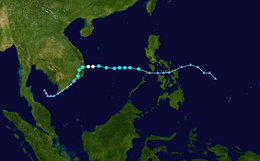Typhoon Joan (1964)
Typhoon Joan was the deadliest storm of the 1964 Pacific typhoon season, and it brought heavy flooding that killed 7,000 people in Vietnam.[1]
| Category 1 typhoon (SSHWS) | |
 track of Joan | |
| Formed | November 4, 1964 |
|---|---|
| Dissipated | November 11, 1964 |
| Highest winds | 1-minute sustained: 130 km/h (80 mph) |
| Lowest pressure | 1000 hPa (mbar); 29.53 inHg |
| Fatalities | 7,000 death |
| Areas affected | Vietnam |
| Part of the 1964 Pacific typhoon season | |
Meteorological history
Similar to the formation of Typhoon Iris, Typhoon Joan originated from a tropical disturbance over the western South China Sea on November 5. Tracking eastward, the system quickly organized and was immediately declared a tropical storm on November 6. Early the next day, a reconnaissance plane recorded a pressure of 1000 mbar (hPa), the lowest in relation to Joan; however, this was measured while the system was a minimal tropical storm. Continued development took place over the following day as a well-defined wall cloud developed within the system.[2] Joan attained typhoon intensity during the afternoon of November 8 and reached its peak intensity with winds of 130 km/h (80 mph) shortly thereafter.[3]Typhoon Joan made landfall in nearly the same location as Typhoon Iris in central Vietnam before rapidly weakening over land. The system eventually weakened to a tropical depression on November 9 before dissipating over Laos.[2]
Impact
| Rank | Typhoon | Season | Fatalities |
|---|---|---|---|
| 1 | "Haiphong" | 1881 | 300,000[4] |
| 2 | Nina | 1975 | 229,000[4] |
| 3 | July 1780 Typhoon | 1780 | 100,000[5] |
| 4 | July 1862 Typhoon | 1862 | 80,000[6] |
| 5 | "Swatow" | 1922 | 60,000[4] |
| 6 | "China" | 1912 | 50,000[4] |
| 7. | "Hong Kong" | 1937 | 10,000[4] |
| 8 | Joan | 1964 | 7,000[7] |
| 9 | Haiyan | 2013 | 6,352[8] |
| 10. | Vera | 1959 | >5,000[4] |
| Main article: List of tropical cyclone records | |||
Due to the rapid succession of Typhoons Iris and Joan, widespread flooding and catastrophic flooding was reported across central South Vietnam. Roughly 90% of structures in three provinces were damaged by the storms and nearly one million were estimated to have been left homeless. Military operations during the Vietnam War were suspended by the typhoons. Joan killed 7,000 people in Vietnam by flood.[1]
See also
- Typhoon Iris (1964)
References
- Associated Press (November 16, 1964). "Another Typhoon Descends on Flood Stricken Vietnam". The Milwaukee Journal. p. 2. Retrieved March 11, 2010.
- Joint Typhoon Warning Center (1965). "Typhoon Joan Summary" (PDF). United States Navy. Archived from the original (PDF) on 2011-06-06. Retrieved March 11, 2010.
- Joint Typhoon Warning Center (1965). "Typhoon 44W (Joan) Best Track". United States Navy. Retrieved March 11, 2010.
- "The Worst Natural Disasters by Death Toll" (PDF). National Oceanic and Atmospheric Administration. 2009. Retrieved January 2, 2012.
- Pedro Ribera, Ricardo Garcia-Herrera and Luis Gimeno (July 2008). "Historical Deadly Typhoons in the Philippines". Weather. Royal Meteorological Society. 63 (7): 196. doi:10.1002/wea.275.
- https://hub.hku.hk/bitstream/10722/188774/2/Content.pdf?accept=1
- Associated Press (November 16, 1964). "Another Typhoon Descends on Flood Stricken Vietnam". The Milwaukee Journal. p. 2. Retrieved March 11, 2010.
- SitRep No.108 re Effects of Typhoon YOLANDA (HAIYAN) (PDF) (Report). National Reduction Risk Reduction And Management Council. April 3, 2014. Retrieved December 2, 2014.